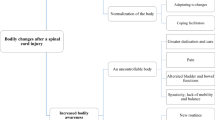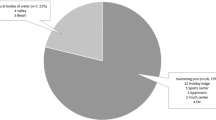Abstract
Longitudinal data and clinical experience indicate that a greater proportion of spinal cord injuries result in incomplete or resolving neurological lesions. Although it has been reported that persons with incomplete injuries enjoy better functional outcomes, routine contacts with these individuals indicate that many experience problems and complications strikingly similar to those with complete spinal cord injuries. Thus, to document the issues and needs of these individuals, data from Colorado's population-based spinal cord injury surveillance program were analyzed. Of 330 persons registered since January 1, 1986, 121 (37%) were found to be minimally disabled (Frankel class D or E). Review of medical records and follow up documentation for these individuals indicated that although over 75% were ambulatory and virtually all were physically independent, more than 80% did report problems in one or more areas: 21% had orthopedic issues and 17% faced additional spinal surgery; 16% reported neurological deterioration or increased spasticity; 25% had pain problems; and 16% had bladder difficulties. Other issues included bowel problems, blood pressure abnormalities, skin breakdown, sexual difficulties, depression, and unemployability. Implications for rehabilitation are discussed in the light of these and other findings.
Similar content being viewed by others
Log in or create a free account to read this content
Gain free access to this article, as well as selected content from this journal and more on nature.com
or
References
Stover S L, Fine P R (1986) Spinal Cord Injury: Facts and Figures University of Alabama, Birmingham, Ab.
Colorado Department of Health, Division of Prevention Programs (1990) 1989 Annual Report of the Spinal Cord Injury Early Notification System. Colorado Department of Health, 4210 East 11th Ave, Denver, Colorado.
Young J S, Burns P E, Bowen A M, McCutchen R (1982) Spinal Cord Injury Statistics. Good Samaritan Medical Center, Phoenix, Az.
World Health Organization (1978) International Classification of Diseases. Clinical Modification (ICD-9-CM). 9th revision. Edwards Brothers Inc, Ann Arbor, Mi.
Fine P R, Kuhlemeier K V, DeVivo M J, Stover S L (1979) Spinal cord injury: an epidemiological perspective. Paraplegia 17: 237–250.
Kraus J F (1980) Injury to the head and spinal cord: the epidemiologic relevance of the medical literature published from 1960-1978. J Neurosurg 53: 3–10.
Kraus J F, Franti C E, Riggins R S, Richards D, Borhani N O (1975) Incidence of traumatic spinal cord injury lesions. J Chron Dis 28: 471–492.
Kurtzke J F (1975) Epidemiology of spinal cord injury. Exp Neurol 3(2): 163–236.
Griffin M R, Opitz J L, Kurland L T, Ebersold M J, O'Fallon W M (1985) Traumatic spinal cord injury in Olmsted County, Minnesota. Am J Epidemiol 121(6): 884–895.
Frankel H L, Hancock D O, Hyslop G, Melzak L S, Michaelis G H, Ungar J D S et al (1969) The value of postural reduction in the initial management of closed injuries of the spine with paraplegia and tetraplegia. Paraplegia 7: 179–192.
Colorado Department of Labor and Employment. Personal communication: November 1989 data.
Author information
Authors and Affiliations
Rights and permissions
About this article
Cite this article
Gerhart, K., Johnson, R. & Whiteneck, G. Health and psychosocial issues of individuals with incomplete and resolving spinal cord injuries. Spinal Cord 30, 282–287 (1992). https://doi.org/10.1038/sc.1992.70
Issue date:
DOI: https://doi.org/10.1038/sc.1992.70



